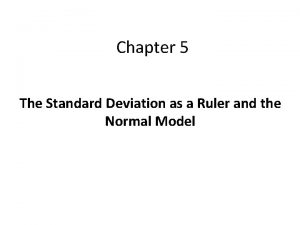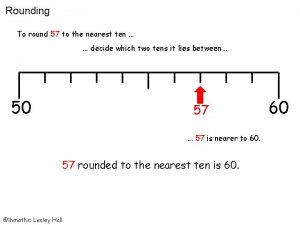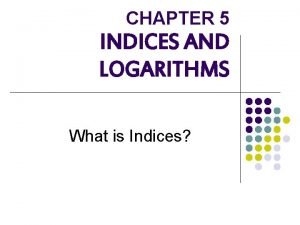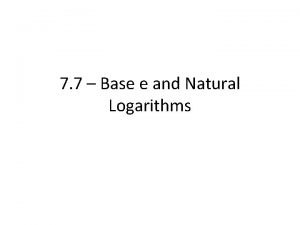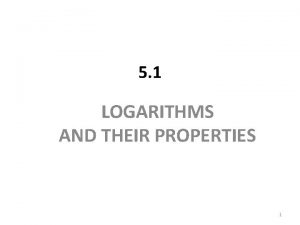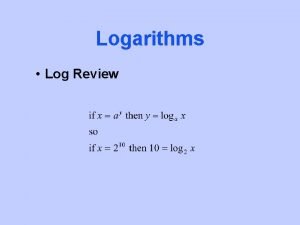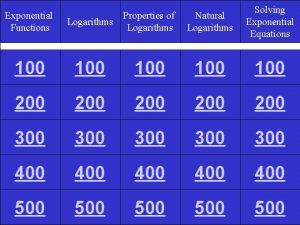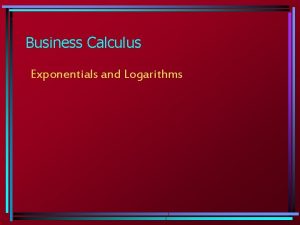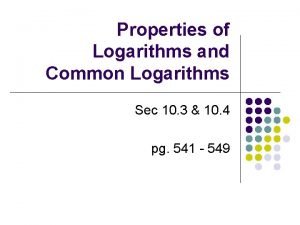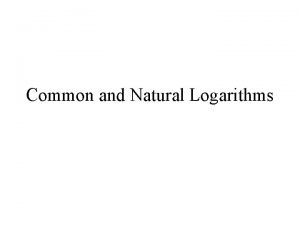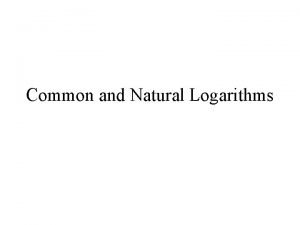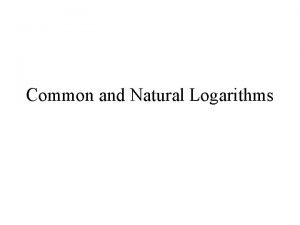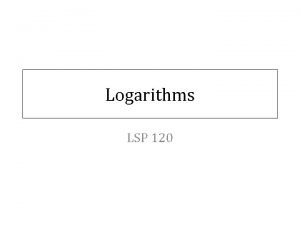Exponentials logarithms and rescaling of data Math 151



























- Slides: 27

Exponentials, logarithms and rescaling of data Math 151 Based upon previous notes by Scott Duke. Sylvester as an adjunct to the Lecture notes posted on the course web page

Definitions • f(x) = ax, exponential function with base a • f(x) = logax, logarithm of x base a • f(x) = axb, is an allometric function

Motivation • Many biological phenomena are non-linear: Population growth Relationship between different parts/aspects of an organism (allometric relationships) The number of species found in a given area (species-area relationships) Radioactive decay and carbon dating Many others • Exponentials, logs and allometric functions are useful in understanding these phenomena

• Population growth is a classic example Algae : cell division Geometric growth 32 2 4 t=0 1 2 1 8 16 3 4 64 … 5 6


Exponentials f(x) = ax, a > 0 a>1 exponential increase As x becomes very negative, f(x) gets close to zero 0<a<1 exponential decrease As x becomes very positive, f(x) gets close to zero

• Special case, a = 1

• f(x) = ax is one-to-one. For every x value there is a unique value of f(x). • This implies that f(x) = ax has an inverse. • f-1(x) = logax, logarithm base a of x.

f(x) = ax f(x) = logax

• logax is the power to which a must be raised to get x. • y = logax is equivalent to ay = x • f(f-1(x)) = alogax = x, for x > 0 • f-1(f(x)) = logaax = x, for all x. • There are two common forms of the log fn. a = 10, log 10 x, commonly written a simply log x a = e = 2. 71828…, logex = ln x, natural log. • logax does not exist for x ≤ 0.

Laws of logarithms • • • loga(xy) = logax + logay loga(x/y) = logax - logay logaxk = k·logax logaa = 1 loga 1 = 0 Example 15. 7 :

• Example 15. 8 : Radioactive decay A radioactive material decays according to the law N(t)=5 e-0. 4 t When does N = 1? For what value of t does N = 1?

To compute logax if your calculator doesn’t have loga or use Example:

• general formula for a simple exponential function: f(x) = ��x or y = ��x Then ln(y) = ln ��x ln(y) = ln �+ ln (�x ) ln(y) = ln �+ x ln � Let b = ln �, and m = ln �, Y=ln (y) then this shows Y = b + mx which is the equation of a straight line. This is an example of transforming (some) non-linear data so that the transformed data has a linear relationship. An exponential function gives a straight line when you plot the log of y against x (semi-log plot). Special exponential form : f(x) = emx

Consider the algae growth example again. How do you know when a relationship is exponential? Regular plot N= t Semilog plot ln(N) = mt+b

• Fit a line to the transformed data • Estimate the slope and intercept using the least squares method. • Y=mx+b • b~0, m = 0. 693. . • Estimate and . b = ln� -> �= eb = e 0 = 1 m = ln� -> �= em = e 0. 693. . = 2. 0 N = 2 t ln(N) = (0. 693)t N=2 t

Example 17. 9 : Wound healing rate Regular plot Semilog plot

• How do you make a semilog plot? • Use the semilog(x, y) command in Matlab • Take the log of one column of data and plot the transformed data (here log y) against the untransformed data (here x)

• Estimate slope and intercept using least squares • Y = b+mx • m = -0. 048 • b = 4. 69 • b = ln -> = eb = e 4. 69 = 108. 85 • m = ln -> = em = e 0. 048 = 0. 953 • A = 108. 85(0. 953)t ln(A)=4. 96 -0. 048 t A=108. 85(0. 953)t

a f(x)=bx • Allometric relationships (also called power laws) • Describes many relationships between different aspects of a single organism: Length and volume Surface area and volume Body weight and brain weight Body weight and blood volume • Typically x > 0, since negative quantities don’t have biological meaning.

a>1 a=1 a<0

f(x) = bax f(x) = bxa

• Example : It has been determined that for any elephant, surface area of the body can be expressed as an allometric function of trunk length. • For African elephants, a=0. 74, and a particular elephant has a surface area of 20 ft 2 and a trunk length of 1 ft. • What is the surface area of an elephant with a trunk length of 3. 3 ft? • x = trunk length • y= surface area • y = bxa = bx 0. 74 • 20 = b(1)0. 74 20 = b • y=20 x 0. 74 • y=20(3. 3)0. 74=48. 4 ft 2

• How do you know when your data has an allometric relationship? • Example 17. 10

Regular plot Semilog plot log-log plot

• How do you make a log-log plot? • Use the loglog(x, y) command in matlab • Take the log of both columns of data and plot the transformed columns.

• • • Y=bxa ln(y)=ln(bxa) ln(y) = ln(b) + ln(xa) ln(y) = ln(b) + a ln(x) Let Y = ln(y) X=ln(x) B=ln(b) Then Y=B + a X Which is the equation for a straight line. So an allometric function gives a straight line on a loglog plot.
 Relationship between exponentials & logarithms
Relationship between exponentials & logarithms Shifting and rescaling data worksheet
Shifting and rescaling data worksheet Chapter 4 exponential and logarithmic functions
Chapter 4 exponential and logarithmic functions Rescaling cos'è
Rescaling cos'è 326 rounded to the nearest ten
326 rounded to the nearest ten Chm 151 final exam
Chm 151 final exam Model netics
Model netics Conforme a tua infinita graça numero
Conforme a tua infinita graça numero Econ 151
Econ 151 Application software consists of
Application software consists of 118/151
118/151 Uci cs specialization
Uci cs specialization Tổng kết vốn từ 151
Tổng kết vốn từ 151 Immurel
Immurel Apsc 143 queens
Apsc 143 queens 1,151,725 bytes
1,151,725 bytes Sucrose solubility curve
Sucrose solubility curve Mcb 317 uiuc
Mcb 317 uiuc Gdp formula
Gdp formula Scia antincendio esempio
Scia antincendio esempio Econ 151
Econ 151 Sjsu cs 151
Sjsu cs 151 Cs 151 sjsu
Cs 151 sjsu Derivatives of inverse functions and logarithms
Derivatives of inverse functions and logarithms Logarithms
Logarithms 7-7 base e and natural logarithms
7-7 base e and natural logarithms 7-3 logarithmic functions answers
7-3 logarithmic functions answers What is a logarithm
What is a logarithm

